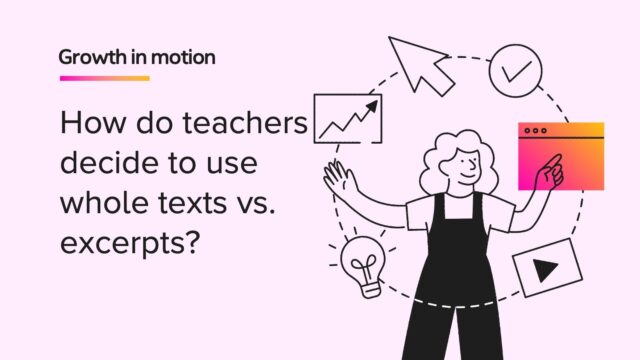
Photos: Courtesy of Katie Risolo Radovich
While virtual learning poses many questions for teachers, one of the critical questions I had as a first-grade teacher with a hybrid class was: how can I teach my students to read virtually? As I reflect on my school year, here’s a list of tips I created for teaching reading online. I thought about what has been working for me, along with what I’ve been doing to help my students succeed in reading.
Tips for teaching reading online
1. Use two devices when reading aloud with students virtually
Before we dive into the actual teaching component, it’s important that you’re set up and prepared with the right technology. Whether you’re using Google Meet, Zoom, or another digital platform, I recommend having one device where you share your screen with students so they can view the digital resources you’re using, or using a Doc Cam or other webcam to share physical resources. Then, you would use the other device to engage with your students! A plus is also being able to see what your students see so you can adjust accordingly.
2. Administer reading and benchmark assessments
It’s critical to have a baseline of your students’ performance so you can determine any specific areas of need. Every school uses different curriculum resources to determine reading levels, so leverage whatever you have access to in a virtual setting. Many resources have digital supplements which are perfect for remote assessment. If not, I recommend researching whether any kind teachers have created benchmarking resources for you already!
Ultimately, not everything you have at your disposal may be digital. For example, I have a benchmark assessment kit that doesn’t have any digital components, and everything inside of it (for instance, teacher’s guide, student workbook, and leveled readers) are all physical copies. Sometimes I quickly turn physical resources into a Google Slide or a Seesaw activity, or I simply use a webcam for the students to see physical resources. I also recommend creating a schedule of times to meet with each child individually during the school day. You can create a breakout section in the virtual classroom so you can work with that one student while also keeping an eye on any other virtual learners. Give yourself ample time!
My rule of thumb for benchmarking my students in reading is Beginning of the Year (BOY), Middle of the Year (MOY), and End of the Year (EOY). But it’s important to know it’s never too late to get started!
3. Group students based on their present levels
Your students will now be separated into their reading groups. Devote time every week to meet with all groups. Finding the time to make this happen isn’t always easy, whether it’s in the hybrid format or not! I recommend meeting with groups when other students are reading or working independently. I like to use a “Must Do, May Do” list that I put on the board for both in-person and at-home learners to see. “Must Do” is what the students have to complete when they aren’t working in reading groups. This is typically work that’s independent, working on a previously taught skill, or independent reading assignments. “May Do” are the activities you set aside for students who have completed their “Must Do” list and are either done early or waiting for their turn with their reading group. I read through the list, model what they have to do for each item, and have students repeat what it says before breaking into groups.

Note: This does take time! Students will need to learn to get accustomed to devoting time to working on their reading skills independently. But once they do, it makes the rest of the year move smoothly.
4. Try round-robin reading
A way to reach every student throughout the week when teaching reading remotely—whether it be aloud, in small groups, or independently—is to give them the opportunities to read aloud to their classmates. It doesn’t even have to be solely during ELA; reading can be worked on across all disciplines!
Give students the opportunity to read out loud as much as possible. This can take the form of reading directions for an activity or worksheet or having students take turns reading word problems in math or photo captions in science and social studies. Whatever the subject matter is, all students can participate in reading in any classroom format.
I like to switch off between having in-person and virtual learners read out loud. Sometimes I will keep a checklist to make sure I heard everyone’s voice that day. The best way to understand whether a student truly grasps a concept is to see them apply that concept or skill in context independently and correctly.
5. Stop for comprehension regularly
Besides reading, comprehension is the most critical skill to truly master concepts. Just because someone can read something doesn’t mean they understand it! This is incredibly true for students.
When teaching reading virtually, I find myself constantly stopping to check for comprehension with my students. To do this, you can ask questions such as: What does that word mean? What is the author telling us? What is happening so far in the story? Why did the character say that?
Give students as many opportunities to read as possible—whether it be whole-class or independent. You may opt to provide digital resources of virtual libraries for students so that they have continuous access to literature, or you may be able to provide books to students. Whatever the case may be, allot time every day for reading!
The views expressed in this article are those of the author and do not necessarily represent those of HMH.
***
Explore HMH literacy solutions with these digital samples of HMH Into Reading and HMH Into Literature.
This blog post, originally published in 2021, has been updated for 2024.
Be the first to read the latest from Shaped.












